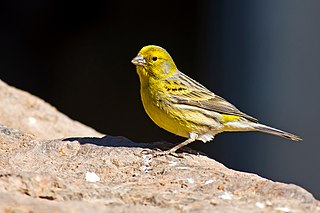
The Atlantic canary, known worldwide simply as the wild canary and also called the island canary, common canary, or canary, is a small passerine bird belonging to the genus Serinus in the finch family, Fringillidae. It is native to the Canary Islands, the Azores, and Madeira. Wild birds are mostly yellow-green, with brownish streaking on the back. The species is common in captivity and a number of colour varieties have been bred.

Macaronesia is a collection of four volcanic archipelagos in the North Atlantic Ocean, off the coasts of the continents of Europe and Africa. Each archipelago is made up of a number of Atlantic oceanic islands, which are formed by seamounts on the ocean floor and have peaks above the ocean's surface. Some of the Macaronesian islands belong to Portugal, some belong to Spain, and the rest belong to Cape Verde. Politically, the islands belonging to Portugal and Spain are part of the European Union. Geologically, Macaronesia is part of the African tectonic plate. Some of its islands - the Azores - are situated along the edge of that plate at the point where it abuts the Eurasian and North American plates.

Phoenix is a genus of 14 species of palms, native to an area starting from the Canary Islands in the west, across northern and central Africa, to the extreme southeast of Europe (Crete), and continuing throughout southern Asia from Turkey east to southern China and Malaysia. The diverse habitats they occupy include swamps, deserts, and mangrove sea coasts. Most Phoenix species originate in semiarid regions, but usually occur near high groundwater levels, rivers, or springs. The genus is unusual among members of subfamily Coryphoideae in having pinnate, rather than palmate leaves; tribe Caryoteae also have pinnate or bipinnate leaves.
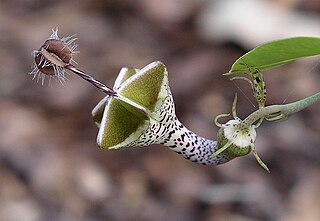
Ceropegia is a genus of plants within the family Apocynaceae, native to Africa, southern Asia, and Australia. It was named by Carl Linnaeus, who first described this genus in volume 1 of his Species plantarum, which appeared in 1753. Linnaeus thought that the flowers looked like a fountain of wax. From this the scientific name was derived: kērós meaning wax and pēgḗ meaning fountain. They have many common names including lantern flower, parasol flower, parachute flower, bushman’s pipe, string of hearts, snake creeper, wine-glass vine, rosary vine, and necklace vine.

Limonium is a genus of 120 flowering plant species. Members are also known as sea-lavender, statice, caspia or marsh-rosemary. Despite their common names, species are not related to the lavenders or to rosemary. They are instead in Plumbaginaceae, the plumbago or leadwort family. The generic name is from the Latin līmōnion, used by Pliny for a wild plant and is ultimately derived from the Ancient Greek leimon.

Aichryson is a genus of about 15 species of succulent, subtropical plants, mostly native to the Canary Islands, with a few in the Azores, Madeira and Morocco, and one in Portugal.
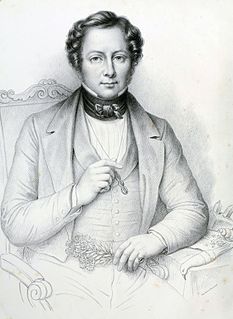
Philip Barker Webb was an English botanist.
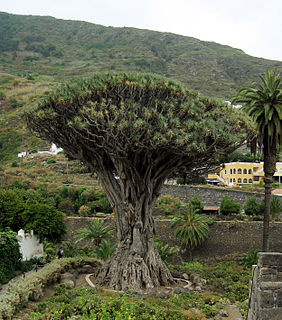
Dracaena draco, the Canary Islands dragon tree or drago, is a subtropical tree in the genus Dracaena, native to the Canary Islands, Cape Verde, Madeira, western Morocco, and is thought to be introduced in the Azores. It is the natural symbol of the island of Tenerife, together with the blue chaffinch. Its closest living relative is the dragon's blood tree of Socotra, Dracaena cinnabari.

Persea is a genus of about 150 species of evergreen trees belonging to the laurel family, Lauraceae. The best-known member of the genus is the avocado, P. americana, widely cultivated in subtropical regions for its large, edible fruit.

Argyranthemum is a genus of flowering plants belonging to the family Asteraceae. Members of this genus are sometimes also placed in the genus Chrysanthemum.

Schizogyne is a plant genus in the stinkwort tribe within the daisy family. It was established in 1828 by French botanist Alexandre de Cassini.

Phoenix canariensis is a species of flowering plant in the palm family Arecaceae, native to the Canary Islands. It is a relative of Phoenix dactylifera, the true date palm. It is the natural symbol of the Canary Islands, together with the canary Serinus canaria. Mature P. canariensis are often used in ornamental landscaping and are collected and transplanted to their new planting location. A Canary Island date palm with 10 m (30 ft) of trunk is approximately 60 years of age.
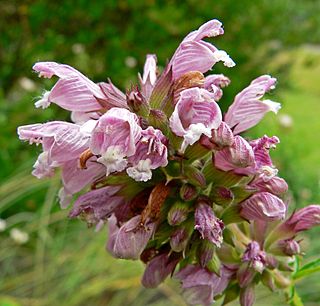
Cedronella is a genus of flowering plants in the tribe Mentheae of the family Lamiaceae, comprising a single species, Cedronella canariensis, native to the Canary Islands, the Azores, and Madeira. It is also naturalized in various places. Common names include Canary Islands-balm, Canary balm, and Balm-of-Gilead.

Micromeria is a genus of flowering plants in the mint family, Lamiaceae, widespread across Europe, Asia, Africa, and North America, with a center of diversity in the Mediterranean region and the Canary Islands. It is sometimes placed within the genus Satureja. The name is derived from the Greek words μῑκρος (mīkros), meaning "small," and μερίς (meris), meaning "portion," referring to the leaves and flowers.
- Micromeria acropolitanaHalácsy - Greece
- Micromeria albanica(K.Malý) Šilic - Albania, Yugoslavia
- Micromeria × angosturaeP.Pérez Gran Canaria in the Canary Islands (M. tenuis subsp. linkii × M. varia subsp. canariensis)
- Micromeria arganietorum(Emb.) R.Morales - Morocco
- Micromeria benthamiiWebb & Berthel. - Gran Canaria in the Canary Islands
- Micromeria × benthamineolensSvent. - Gran Canaria in the Canary Islands (M. benthamii × M. pineolens)
- Micromeria biflora(Buch.-Ham. ex D.Don) Benth. - Himalayas from Afghanistan to Myanmar
- Micromeria × bourlieriMaire & Le Lièvre - Algeria, Morocco (M. graeca × M. inodora)
- Micromeria brivesiiBatt. - Morocco
- Micromeria × broussonetiiA.Santos, A.Acev.-Rodr. & Reyes-Bet. - Canary Islands (M. densiflora × M. varia)
- Micromeria browicziiZiel. & Kit Tan - Greece
- Micromeria chionistraeMeikle - Cyprus
- Micromeria conferta(Coss. & Daveau) Stefani - Libya
- Micromeria × confusaG.Kunkel & P.Pérez - Gran Canaria in the Canary Islands (M. benthamii × M. lanata)
- Micromeria cremnophilaBoiss. & Heldr. - Albania, Greece, Turkey, Syria, Lebanon
- Micromeria cristata(Hampe) Griseb. - Albania, Greece, Yugoslavia, Turkey, Bulgaria, Iran, Cyprus
- Micromeria croatica(Pers.) Schott - Albania, Yugoslavia
- Micromeria cymuligeraBoiss. & Hausskn. - Turkey
- Micromeria danaensisDanin - Jordan
- Micromeria debilisPomel - Algeria, Morocco
- Micromeria densifloraBenth. - Tenerife in the Canary Islands
- Micromeria douglasii(Benth.) Benth. – Yerba buena - Alaska, British Columbia, Washington, Oregon, California, Idaho, Montana
- Micromeria ellipticaK.Koch - Turkey
- Micromeria filiformis(Aiton) Benth. - Corsica, Sardinia, Balearic Islands
- Micromeria flacca(Nábelek) Hedge - Turkey, Iraq
- Micromeria flagellarisBaker - Madagascar
- Micromeria fontanesiiPomel - Algeria, Morocco
- Micromeria forbesiiBenth. - Cape Verde Islands
- Micromeria fruticosa(L.) Druce - Eastern Mediterranean
- Micromeria glomerataP.Pérez - Tenerife in the Canary Islands
- Micromeria graeca(L.) Benth. ex Rchb. - Mediterranean from Morocco + Portugal to Turkey
- Micromeria guichardii(Quézel & Zaffran) Brullo & Furnari - Libya
- Micromeria hedgeiRech.f. - Iran
- Micromeria helianthemifoliaWebb & Berthel. - Gran Canaria in the Canary Islands
- Micromeria herpyllomorphaWebb & Berthel. - La Palma in the Canary Islands
- Micromeria hispidaBoiss. & Heldr. ex Benth. - Crete
- Micromeria hochreutineri(Briq.) Maire - Algeria, Morocco
- Micromeria × hybridaZagan - Greece including Crete (M. graeca × M. nervosa)
- Micromeria hyssopifoliaWebb & Berthel. - Tenerife + El Hierro in the Canary Islands
- Micromeria imbricata (Forssk.)C.Chr. - Africa from Nigeria to Ethiopia to Transvaal, Arabian Peninsula
- Micromeria inodora(Desf.) Benth. - Algeria, Morocco, Tunisia, Spain including Balearic Islands
- Micromeria × intermediaG.Kunkel & P.Pérez - Gran Canaria in the Canary Islands (M. benthamii × M. helianthemifolia)
- Micromeria juliana(L.) Benth. ex Rchb. - Mediterranean
- Micromeria kerneriMurb. - Yugoslavia
- Micromeria lachnophyllaWebb & Berthel. - Tenerife in the Canary Islands
- Micromeria lanata(C.Sm. ex Link) Benth. - Gran Canaria in the Canary Islands
- Micromeria lasiophyllaWebb & Berthel. - Canary Islands
- Micromeria lepidaWebb & Berthel. La Gomera in the Canary Islands
- Micromeria leucanthaSvent. ex P.Pérez - Gran Canaria in the Canary Islands
- Micromeria longipedunculataBräuchler - Yugoslavia, Albania
- Micromeria macrosiphonCoss. - Morocco
- Micromeria madagascariensisBaker - Madagascar
- Micromeria marginata(Sm.) Chater - Alpes Maritimes in France, Liguria + Sardinia in Italy
- Micromeria × meteoricaHausskn. - Greece (M. cremnophila × M. juliana)
- Micromeria microphylla(d'Urv.) Benth. - Balearic Islands, Sicily, Malta, southern mainland Italy, Crete, Cyprus, Libya
- Micromeria monantha(Font Quer) R.Morales - Morocco
- Micromeria myrtifoliaBoiss. & Hohen. - from Greece to Iran
- Micromeria nervosa(Desf.) Benth. - Mediterranean from Algeria + Balearic Islands to Turkey
- Micromeria × nogalesiiG.Kunkel & P.Pérez - Gran Canaria in the Canary Islands
- Micromeria peltieri(Maire) R.Morales - Morocco
- Micromeria × perez-paziiG.Kunkel - Gran Canaria in the Canary Islands (M. benthamii × M. tenuis)
- Micromeria persicaBoiss. - Iran, Iraq, Turkey
- Micromeria pineolensSvent. - Gran Canaria in the Canary Islands
- Micromeria × preauxiiWebb & Berthel. - Gran Canaria in the Canary Islands (M. benthamii × M. varia subsp. canariensis)
- Micromeria pseudocroaticaŠilic - Yugoslavia
- Micromeria rivas-martineziiWildpret - Tenerife in the Canary Islands
- Micromeria serbalianaDanin & Hedge - Sinai
- Micromeria sinaicaBenth. - Sinai, Israel
- Micromeria sphacioticaBoiss. & Heldr. ex Benth.- Crete
- Micromeria sphaerophyllaBaker - Madagascar
- Micromeria suborbicularis(Alain) Borhidi - Cuba
- Micromeria × tagananensisP.Pérez - Tenerife in the Canary Islands (M. glomerata × M. varia)
- Micromeria teneriffae(Poir.) Benth. ex G.Don - Tenerife in the Canary Islands
- Micromeria tenuis(Link) Webb & Berthel. - Gran Canaria in the Canary Islands
- Micromeria unguentariaSchweinf. - Ethiopia
- Micromeria variaBenth. - Canary Islands, Madeira, Cape Verde Islands
- Micromeria weilleri(Maire) R.Morales - Morocco
- Micromeria × wildpretiiP.Pérez - Tenerife in the Canary Islands (M. rivas-martinezii × M. varia)

The Gibraltar Botanic Gardens or La Alameda Gardens are a botanical garden in Gibraltar, spanning around 6 hectares. The Rock Hotel lies above the park.

Himantoglossum is a genus of orchids native to the Canary Islands, Europe, southwest Asia and northern Africa. Its members generally have a labellum which is divided into three parts, of which the middle part is the longest.

Argyranthemum frutescens, known as Paris daisy, marguerite or marguerite daisy, is a perennial plant known for its flowers. It is native to the Canary Islands. Hybrids derived from this species are widely cultivated as ornamental plants in private gardens and public parks in many countries, and have naturalized in Italy and southern California. There are many cultivars, but the most common has white petals.

Leopoldia is a genus of bulbous perennial plants in the family Asparagaceae, subfamily Scilloideae. The genus is widespread around the Mediterranean region and neighboring lands, from the Canary Islands to Iran.

Semele is a genus of flowering plants native to the Canary Islands and Madeira. In the APG III classification system, it is placed in the family Asparagaceae, subfamily Nolinoideae.

Zenodochium polyphagum is a moth in the family Blastobasidae. It is found on the Canary Islands.



















